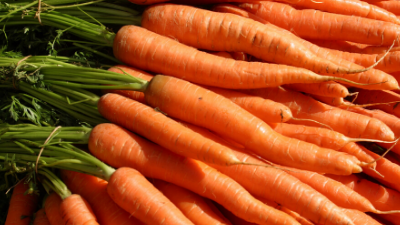How to Grow Carrots.
Summary
Carrots are cool season vegetables that prefer sunny locations and fertile, deep, well-drained soils. Incorporate plenty of organic matter and a complete fertilizer into the area before planting. Plant seeds ¼-½ inch deep. Thin seedling carrots to 3 inches apart in the row with rows 12-18 inches apart. Plant 2-3 weeks before the last frost. Carrots taste best when plants grow rapidly and mature before the heat of summer. Avoid water or fertilizer stress during growth. Irrigation should be frequent and uniform to ensure good growth. Control insect and diseases throughout the year. Harvest carrots when the leaves reach full size.
Carrot Varieties
There are many good carrot varieties for sale in local gardening outlets and through seed catalogs. Most grow well in Utah. Carrots come in a variety of root types, uses, shapes, and colors. Consult on-line seed sources or local garden centers and seed suppliers for availability.
How to Grow Carrots
Soils
Carrots prefer fertile, well-drained, deep, sandy soils rich in organic matter for best growth. Most light soils in Utah are well suited for carrot production. Heavy soils need to be amended with plenty of compost and should be double dug to allow good root development.
Soil Preparation
Before planting, determine fertilizer needs with a soil test and then follow the recommendations given with the test report. If fertilizer applications are warranted, work the fertilizer into the top 6 inches of soil. If you fertilize with compost, apply no more than 1 inch of well-composted organic matter per 100 square feet of garden area.
Plants
Carrots are always grown from seed. Carrots can be sown after soils reach 40°F. Seeds germinate best at 55-65°F and require 14-21 days to emerge. Temperatures above 80°F reduce seed germination. Carrots grow best when temperatures do not exceed 75°F. Temperatures down to 32°F do not seriously damage plants. High summer temperatures reduce growth, decrease quality, and cause bitter or off-flavors to develop.
Planting and Spacing
Seeds should be planted ¼ inch deep and thinned when plants have 3-4 true leaves. Crusting soils will limit seedling emergence and affect plant stands. Plant seeds on soil surface, then cover seed with compost or fine sand to help with stand establishment. Maintain a uniform and moist soil surface to ensure good plant stands. Seeded carrots should be spaced 2-3 inches between plants in the row with rows 12-18 inches apart. Dense plantings will reduce weed pressure. Planting radishes with carrots helps minimize the crusting problem and identifies where the planted rows are. Some gardeners sow seeds in wide beds rather than rows. For season long production, plant carrots every 4 weeks through mid-summer.
Water
Water carrots regularly. Water requirements depend on soil type. Use drip irrigation if possible. Avoid over-watering as hairy roots will form and forking will occur. Mulch around the plants to conserve soil moisture. Moisture fluctuations can cause root disorders, slow leaf development, and contribute to bitterness. Wet and dry periods favor root cracking.
Fertilization
Apply ¼ cup of a nitrogen-based fertilizer (21-0-0) per 10 feet of row 6 weeks after emergence to encourage rapid plant and root growth. Place the fertilizer to the side of the plants and irrigate it into the soil.
Problems with Growing Carrots
Weeds
Carrots do not compete well with weeds. Weed control is particularly important during germination and establishment. Avoid deep cultivation near the plants as root pruning and damage will affect growth and yield.
Insects and Diseases
Most carrots are fast growing and have few production problems. Rotating planting locations in the garden each year helps control many diseases.
Insect |
Identification |
Control |
|---|---|---|
| Carrot Fly | Small white maggots that feed on and burrow into the developing root. | Use soil applied chemicals at planting or cover young emerging seedlings with fabric row covers to exclude egg-laying adults. |
Disease |
Symptom |
Control |
| Leaf Blights | Fungal diseases that cause spotting on infected leaves. | Occur when foliage remains wet for long periods |
| Root Rots and Spots | Fungal diseases that cause decay and rotting of the root. Leads to forking and off-shaped roots. | Crop rotation. Soil solarization. |
| Yellows | Multiple tops per plant, yellow discoloration of leaves, and numerous hairy roots. | Carried by leafhoppers. Cover plants with fabric mulch. No known control. |
How to Harvest and Store Carrots
Carrots can be harvested when the roots begin to size. Generally roots are mature in 70-100 days from seeding. Use a digging fork to loosen soil and pull up needed plants by the tops and trim off leaves. Wash and store the roots at 32°F and 95% relative humidity for 2-4 weeks. Plants can be left in the garden after light frosts. Many gardeners overwinter carrots in the garden under heavy mulches and harvest them as needed. Carrots can be stored in moist sand in a cool cellar for several months. Do not store carrots with apples or pears as the fruit gases cause the roots to go bitter.
Carrot Plant Productivity
Plant 5-10 feet of row per person for fresh use and an additional 10-15 feet for storage, freezing, or canning. Expect about 1 lb. of roots per linear foot of planted row.
Carrot Nutrition
Carrots are low in calories and are an excellent source of vitamin A. One 7 inch long root has only 35 calories, no fat, and supplies 270% of the daily vitamin A and 10% of the vitamin C requirement.
Frequently Asked Questions
Why do carrots flower rather than form a root? Carrots require cold weather (chilling) to form flowers. If planted too early, this can occur.
Why do some of my carrots form many roots rather than one long root? Carrots form multiple roots (fork) when damage to the primary root occurs. Forking is associated with rocky, stony, or heavy soils. Carrot fly damage can also cause this problem. Deep digging, the addition of compost, and pest control will help reduce this disorder.
I regularly have very pale yellow colored roots. Why does this happen? Hot weather and hot soil temperatures are responsible for poor color formation in the roots. When temperatures go above 85°F, keep the plants well-watered and mulch around the roots to cool the soil.
Published May 2020
Utah State University Extension
Peer-reviewed fact sheet

